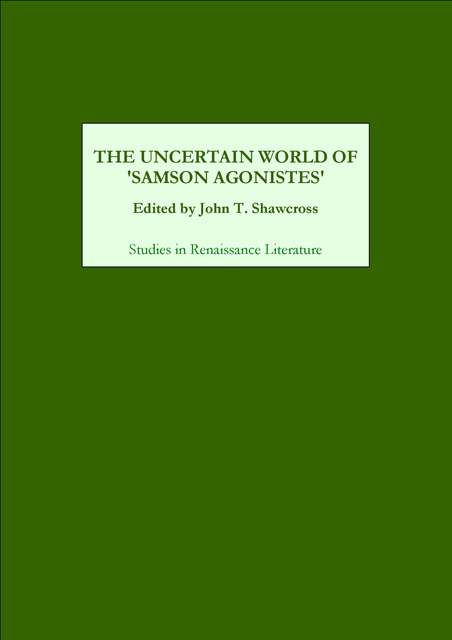Book contents
- Frontmatter
- Contents
- Preface
- Chapter 1 The World of Samson Agonistes
- Chapter 2 Uncertainty and the Text
- Chapter 3 The Dramatic Work and its Reading
- Chapter 4 Samson: God’s Champion, a Type, or Individual?
- Chapter 5 Dalila: Seductress or Wife?
- Chapter 6 Politics in the Destabilized Text
- Chapter 7 Biographical Intrusions
- Chapter 8 The Uncertainties of Irony
- Chapter 9 A Hermeneutics of the Text
- Chapter 10 Samson Agonistes and Consistencies of Belief
- Works Cited
- Index
Chapter 9 - A Hermeneutics of the Text
Published online by Cambridge University Press: 22 March 2023
- Frontmatter
- Contents
- Preface
- Chapter 1 The World of Samson Agonistes
- Chapter 2 Uncertainty and the Text
- Chapter 3 The Dramatic Work and its Reading
- Chapter 4 Samson: God’s Champion, a Type, or Individual?
- Chapter 5 Dalila: Seductress or Wife?
- Chapter 6 Politics in the Destabilized Text
- Chapter 7 Biographical Intrusions
- Chapter 8 The Uncertainties of Irony
- Chapter 9 A Hermeneutics of the Text
- Chapter 10 Samson Agonistes and Consistencies of Belief
- Works Cited
- Index
Summary
SAMSON is led on to the scene out of his prison in Gaza by someone (“Thy guiding hand”), apparently a young Danite, who, one would imagine, stays in close position to aid the blind man, although no further reference is made to him. Someone also leads Samson off alone after line 1426, and this according to the argument could be the Ocer. Samson is brought to the “spacious Theatre” (1615, 1605) “as a public servant,” perhaps by this same officer who conducts him to center stage. Perhaps it is more likely that the young Danite served both to lead Samson to the theater and to the pillars; the Bible specifically refers to “the lad that held him by the hand.” “Where they led him” and later “for intermission sake they led him/ Between the pillars’’ (1623, 1629–30, my italics) sets up some possible confusions. Samson requests that “his guide” let him lean against the Pillars” and “He unsuspitious led him” (1630–35). The messenger’s word “they” may thus mean only that the Philistines allowed such movement to occur, there being but one Philistine guide or the young Danite. But the first-line reference to “Thy guiding hand” also sets up the ambiguity that intended is God’s hand that is operative from the very beginning of the dramatic poem straight through to the denouement when “his guide” enables him to effect the catastrophe. God is invoked by the Chorus when Samson leaves their presence:
Go, and the Holy One
Of Israel be thy guide
To what may serve his glory best.
(1427–29)The text thus supports an interpretation of the full poem as guided by God who oversees Samson’s renovation and triumph of person over the Philistines. Such a reading calls into question the reading of Samson’s death as self-murder and the whole as a narrative of a still boastful, violent, and negative exemplar.
Samson’s “here leave me to respire” (11) suggests further meanings than simply “breathe” or “breathe again” the wholesome air outside the “common Prison.” The word implies the “spiritus” of God and is seconded by the air’s being “The breath of Heav’n fresh-blowing, pure and sweet” (10).
- Type
- Chapter
- Information
- The Uncertain World of Samson Agonistes , pp. 112 - 137Publisher: Boydell & BrewerPrint publication year: 2001

